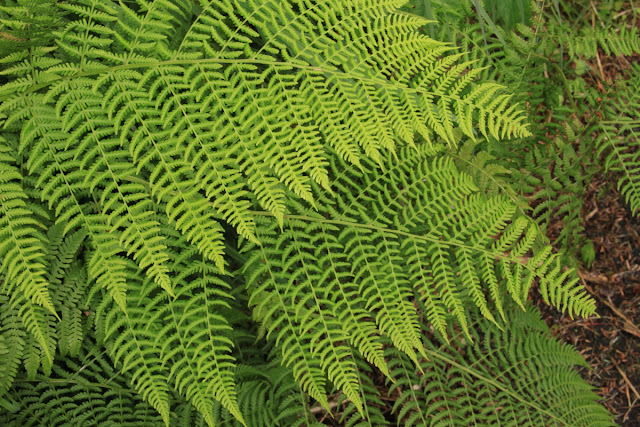We have enjoyed generally good weather on this trip and it is my pleasure to share more photos with you. This posting has less geology and more nature - the Brown bears we saw at Geographic Harbor in Katmai National Park were phenomenal.
This is part of the ruins of Ft. Abercrombie on Kodiak Island. When Kiska Island was taken by the Imperial Japanese Army, the American military fortified many of the other Aleutian Islands in the Pacific. Ft. Abercrombie was one of these fortifications. It is now an Alaska State Park.
Kodiak Island is the 2nd largest island in the United States (Hawai'i is the largest) and contains the extreme northern end of the North American temperate rain forest. The southern-most edge of this rainforest is found way down along California's Big Sur coast.
They do green like the Colorado Plateau does red! Mosses cover the branches of a Sitka spruce tree in the State Park.
Ferns in the rain forest on Kodiak Island.
A road cut in the town of Kodiak exposed deep water marine sediments that are part of the Chugach terrane. See my previous posting for a simple description of terrane geology. A more detailed and scientific description of the Church terrane can be found here. Generally, these rocks were deposited in a deep marine trench like the nearby modern Aleutian trench. These sediments are Late Cretaceous to Eocene in age, about 75 to 55 million years old.
The World at anchor at the mouth of Geographic Harbor in Katmai National Park, Alaska Peninsula.
Foliated intrusive rocks are part of the volcanic complex here.
Note the dark-colored bedrock in the peak and the light-colored talus slopes below it. The lighter material is volcanic ash from the June 6, 1912 eruption of the Novarupta volcano, located about 20 miles north of this spot. The 1912 eruption of Novarupta is considered the largest volcanic eruption on Earth during the entire 20th Century and is surpassed in all of recorded history only by the 1815 eruption of the Tambora volcano in Indonesia. It covered a nearby valley in over 300 feet of pyroclastic material. Even though no one was nearby to record the events of this eruption, modern-day volcanologists with more tools have revealed the sequence of events that occurred here during the 60 hours of eruption. It is now one of the best studied volcanic eruptions known. You can read more about the eruption and its aftermath here (and in the contained links).
In Geographic Harbor, it was difficult to focus on geology as no fewer than nine bears were ambling along the shoreline in this relatively small area.
Close-up of the mother bear seen above. The species is known as the American brown bear (Ursus arctos horribilus), the silver tip bear, or the grizzly bear. They did not seem so fierce when viewed from the safety of a boat.
Viewing bears safely from a Zodiac. They hardly even noticed us quietly sitting out in the water. about 75 meters away It would have been a much different feeling had we been walking ashore or camping here.
Another mother with her two cubs digging for amphipods in the tidal mud.
This cub is about 7 months old. Anyone wanting to see Brown bears in their native habitat got what they wanted on this trip. Next stop - the Semidi Islands.
Zodiacs ready for a landing at the Semidi Islands.
We climbed up to a pass on the island that allowed us to view its rocky shore. Geologically, these islands are a southwest extension of the Chugach terrane and of Kodiak Island.
Close-up of shoreline.
This coast suffers the brunt of harsh winter storms from the open Pacific Ocean. Huge driftwood logs were thrown-up on the shore of cobble beach. In the distance some 10,000 miles is the shoreline of Antarctica, the next bit of land in that direction.

Next stop is the Shumagan Islands and the island of Unga (ninth largest island in the US). We stopped in Delarof Harbor at an abandoned fishing village that provided a great palette for photography.
This is the grave of a young girl who likely died in the influenza epidemic of 1918.
Church steeple in Unga. The village was last inhabited in the 1970s and served as the base for a cod fishery before abandonment.
Two Great horned owls (Bubo virginianus) in a Sitka spruce tree in the village of Unga.
A yellow paintbrush (Castilleja unaleschcensis) is a common wildflower in this part of Alaska.
The World at anchor near the east shore of Unga Island. There is a gold prospect on this island that is gearing ups for operation. So far, 150,000 ounces of gold have been taken from here (in historic time) and the new venture may yield much more. Read about it here.
A northern sea otter (Enhydra lutris kenyoni) rests in the quiet waters of the bay.
Near the outside of Delarof Harbor are these fantastic shapes.
Rock and The World.
A final stop was made on Unimak Island, the easternmost of the Aleutian chain. The Isanotski volcano stands at 8,104 feet above sea level as viewed from Otter Cove looking to the northwest.
Zodiac and The World in morning light in Otter Cove on August 12, 2017.
Bear trackway on the sand at Otter Cove.
This has been a wonderful voyage on The World. Thanks to all of the residents here who make my visit with them possible.

































These photos are WONDERFUL! Makes me regret not getting to Kodiak some other islands when we lived in AK, but being poor with two little ones made it an impossible dream. But I did get to Katmai NP where the first fish I ever caught in my life was a 6 pound salmon and I saw enough brown bears to last me a lifetime. The World is lucky to have you, Wayne.
ReplyDelete